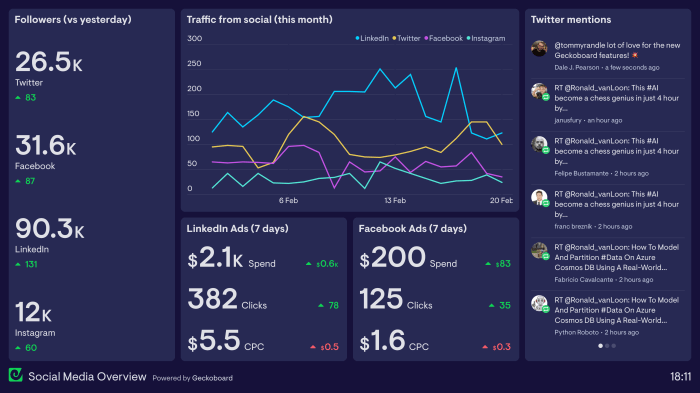Tracking Social Media Engagement sets the stage for businesses to thrive in the digital landscape, providing insights into enhancing interaction with an online audience. From defining social media engagement to analyzing data trends, this journey explores the key elements of measuring success in the virtual realm.
Get ready to dive into the world of social media metrics and engagement strategies that can elevate your brand to new heights.
Introduction to Social Media Engagement Tracking
![]()
Social media engagement refers to the interactions, likes, comments, shares, and overall involvement that users have with a brand’s social media content.
Tracking social media engagement is crucial for businesses as it provides insights into how well their content is resonating with their audience, helps in measuring the effectiveness of their social media strategies, and allows for adjustments to be made to improve engagement and reach.
Social Media Metrics for Engagement Tracking
- Number of likes: This metric shows how many users have appreciated the content enough to hit the like button.
- Comments: Tracking the number of comments can help gauge the level of engagement and interaction with the audience.
- Shares: The number of times content is shared indicates how valuable and engaging it is to users.
- Click-through rate (CTR): This metric measures the percentage of users who clicked on a link included in the post.
Tools for Tracking Social Media Engagement
Tracking social media engagement is crucial for businesses and individuals looking to analyze the impact of their online presence. There are several tools available that can help track and measure social media engagement, providing valuable insights for optimization and growth.
Popular Tools for Tracking Social Media Engagement
- Sprout Social: Sprout Social is a comprehensive social media management tool that offers robust analytics features. It allows users to track engagement metrics across multiple platforms, schedule posts, and monitor brand mentions.
- Hootsuite: Hootsuite is another popular social media management tool that provides analytics for tracking engagement metrics. Users can schedule posts, monitor conversations, and analyze performance across various social media platforms.
Comparison of Sprout Social and Hootsuite
| Features | Sprout Social | Hootsuite |
|---|---|---|
| Analytics | Comprehensive analytics with detailed reports on engagement metrics. | Analytics dashboard offering insights on engagement and performance. |
| Social Listening | Ability to monitor brand mentions and track conversations in real-time. | Includes social listening tools for monitoring brand mentions and industry trends. |
| Post Scheduling | Advanced scheduling features for optimizing posting times. | Efficient post scheduling capabilities for managing content calendars. |
Step-by-Step Guide to Using Sprout Social for Tracking Social Media Engagement
- Sign up for a Sprout Social account and connect your social media profiles.
- Access the analytics dashboard to view engagement metrics such as likes, comments, and shares.
- Monitor brand mentions and track conversations related to your brand or industry.
- Use the scheduling feature to plan and optimize your social media posts for increased engagement.
- Analyze the performance reports to identify trends and make informed decisions for future content strategies.
Strategies for Improving Social Media Engagement
In order to increase engagement on social media platforms, brands need to implement creative and strategic approaches. This involves actively interacting with followers, sharing engaging content, and responding promptly to comments and messages.
Utilize Interactive Content
Using interactive content such as polls, quizzes, and contests can significantly boost engagement levels. These types of posts encourage followers to participate and share their opinions, resulting in increased interaction and reach.
Collaborate with Influencers
Partnering with influencers who align with your brand can help broaden your reach and attract a new audience. Influencers have a loyal following who trust their recommendations, making them valuable allies in increasing engagement.
Engage with User-Generated Content
Encouraging users to create and share content related to your brand can create a sense of community and loyalty. By reposting user-generated content and engaging with those who contribute, brands can foster a stronger connection with their audience.
Host Live Q&A Sessions
Hosting live question and answer sessions allows brands to directly interact with their followers in real-time. This personal touch humanizes the brand and shows followers that their opinions and questions are valued.
Consistently Respond to Comments and Messages
Responding promptly to comments, messages, and mentions shows followers that the brand is attentive and cares about their feedback. This two-way communication fosters a sense of community and trust, leading to increased engagement and brand loyalty.
Analyzing Social Media Engagement Data

When it comes to social media engagement tracking, analyzing the gathered data is crucial for making informed decisions and optimizing your social media strategy. By interpreting the data effectively, you can identify trends, understand your audience better, and improve your engagement rates.
Interpreting Social Media Engagement Data
- Look at key metrics such as likes, shares, comments, and click-through rates to gauge the performance of your social media content.
- Compare data across different platforms to see which ones are most effective for reaching your target audience.
- Consider the timing of your posts and analyze how different posting schedules impact engagement levels.
- Pay attention to the demographics of your audience and tailor your content to better resonate with them.
Identifying Trends in Engagement Data
- Track changes in engagement metrics over time to spot patterns and identify what types of content perform best.
- Monitor the impact of specific campaigns or promotions on your engagement levels to understand what resonates with your audience.
- Use social media analytics tools to visualize data trends and gain insights into your audience’s behavior.
Significance of A/B Testing
- Utilize A/B testing to experiment with different variables such as post timing, content formats, and visuals to see what drives higher engagement.
- Test out different call-to-action phrases or designs to optimize your social media campaigns for better results.
- By conducting A/B tests, you can gather valuable data on what works best for your audience and refine your social media strategy accordingly.
Best Practices for Tracking Social Media Engagement
Tracking social media engagement effectively is crucial for any successful digital marketing strategy. Here are some key best practices to keep in mind:
Setting Measurable Goals for Social Media Engagement
- Define clear objectives: Whether it’s increasing brand awareness, driving website traffic, or boosting sales, make sure your goals are specific and measurable.
- Use SMART criteria: Goals should be Specific, Measurable, Achievable, Relevant, and Time-bound to ensure they are attainable and trackable.
- Track relevant metrics: Focus on metrics that align with your goals, such as likes, comments, shares, click-through rates, and conversions.
The Importance of Consistency in Tracking and Analyzing Engagement Data
- Regularly monitor performance: Track engagement metrics on a consistent basis to identify trends, measure progress, and make data-driven decisions.
- Compare over time: Analyze data over different time periods to see how engagement fluctuates and identify patterns that can inform your strategy.
- Utilize social media analytics tools: Take advantage of platforms’ built-in analytics tools or third-party software to streamline tracking and reporting processes.





